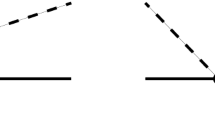Abstract.
The construction of the effective Lagrangian relevant for the mesonic sector of QCD in the large \(N_c\) limit meets with a few rather subtle problems. We thoroughly examine these and show that, if the variables of the effective theory are chosen suitably, the known large \(N_c\) counting rules of QCD can unambiguously be translated into corresponding counting rules for the effective coupling constants. As an application, we demonstrate that the Kaplan–Manohar transformation is in conflict with these rules and is suppressed to all orders in \(1/N_c\). The anomalous dimension of the axial singlet current generates an additional complication: The corresponding external field undergoes nonmultiplicative renormalization. As a consequence, the Wess–Zumino–Witten term, which accounts for the U(3)\(_{\mathrm{R}}\times \)U(3)\(_{\mathrm L}\) anomalies in the framework of the effective theory, contains pieces that depend on the running scale of QCD. The effect only shows up at nonleading order in \(1/N_c\), but requires specific unnatural parity contributions in the effective Lagrangian that restore renormalization group invariance.
Similar content being viewed by others
Author information
Authors and Affiliations
Additional information
Received: 14 July 2000 / Published online: 27 October 2000
Rights and permissions
About this article
Cite this article
Kaiser, R., Leutwyler, H. Large \(N_ c\) in chiral perturbation theory. Eur. Phys. J. C 17, 623–649 (2000). https://doi.org/10.1007/s100520000499
Issue Date:
DOI: https://doi.org/10.1007/s100520000499



